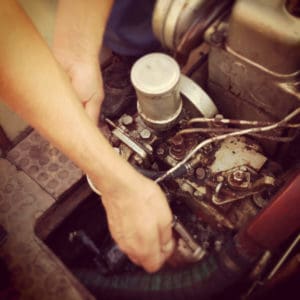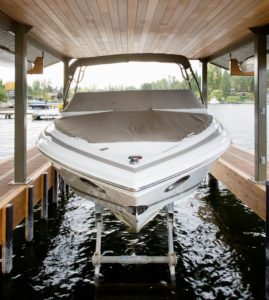You’d be surprised what a fresh layer of paint can do, whether you’re maintaining classic wood, or covering up old or faded coats of paint. Boats lead a pretty rugged life, regardless if they’re used much or not. Maintaining the paint on your boat is an important part of protecting it’s value, defending against weather, water conditions, wear and tear, floating objects and protecting marine life.
While painting can be time-consuming, complex, and expensive, it is necessary, and you can DIY it with the right experience and knowledge.
How to Paint A Boat
Painting a boat takes time and effort, from start to finish, but almost anyone can do it with the right equipment and plenty of available time. Most of the time spent during a boat painting project is the preparation phase. Skipping out on preparation can cost you double when it comes to the painting stage and end up ruining the finished look.
1. Prepping the Boat
- Clean the boat thoroughly
Get everything off the surface, from dirt to seaweed, to sand. It’s easier to clean the surface of the boat as it comes out of the water. You can use a high-pressure hose, a scraper, or rags to make sure your surface is spotless. In the future, keeping your boat routinely clean avoids some extra hard work later. - Remove any hardware
Take off as much hardware and paneling as possible from your boat, like rails, cleats, vents, or any teak/wood trim. Anything you can’t remove should be covered in painter’s tape to keep it protected. - Prep surface
Wash, de-wax, and thoroughly sand the surface of your boat. You can use rough sponges and boat solvents to scrub away any of the finish. Paint will not stick to any waxy surfaces, so the finish needs to be completely removed. - Make necessary repairs
Any nicks, cracks, dings, or gouges should be repaired ahead of painting to prevent holes or imperfections in your final paint job. Using marine-grade epoxy is important, and can be found in any hardware or boat store. - Sand the boat
Using a high grit sandpaper or a finishing sander, sand the entire surface of your boat. This allows some grip for the paint to adhere to, and helps promote an even coat. Sand away any old paint, especially if it’s a different type of paint you plan to apply. Remember paint chips are toxic, so always wear eye protection and a respirator when sanding. Remove all the dust after sanding for no inconsistencies in your finish.
2. Painting the Boat
For the best results, there’s a few things to consider when painting. Make sure to paint on a dry, cool day, as painting with excessive heat, wind, or humidity can ruin the final paint job. If possible, paint in a covered area.
When choosing the right paint for your boat, you’re met with different options on the market – from gel coats to two-step mixes. Depending on your level of expertise, and your boat’s individual needs, you can pick the right one for you.
- Apply 1-2 full coats of primer
Primer helps the paint bond to your boat, and prevents cracking or bubbling. Let each layer completely dry before adding another coat. After your first coat has dried, you can lightly sand before applying the next coat. - Paint the boat using a brush and roller
Working quickly, you can start at the bottom of the boat and work your way up using a roller. Use the roller to help cover more surface area, and go back in with a brush for details and smaller sections after. - Lightly sand dried paint
Depending on the paint used, this can take anywhere from an hour to a full 24 hours. Using 300-grit sandpaper, lightly sand your paint to remove any spots or bubbles. - Apply 2-3 more coats
After sanding lightly after each coat has dried, add another coat of paint. Applying 2-3 layers prevents future cracking or fading.
Painting a boat can be time-consuming, and quite a large job. Not to mention different types of boats call for specific paints, and different parts of the boat require expertise in different methods. But with patience and planning, a thorough, fresh paint job is the best way to have your boat looking new again.
Painting a Boat Bottom
Painting the bottom of a boat is actually much easier than the rest of the boat, because the paint tends to be simpler to apply. It is a bit different than painting the boat’s hull and topsides, and you’ll want specific paint that prevents marine growth.
- De-waxing and sanding is necessary if the bottom of the boat has a gel coat.
- Applying over old paint can skip the dewaxing process and just power wash or sand loose, old paint.
- Some paint has a minimum dry time, so plan your boat’s launch accordingly.
Painting a Boat Hull
Painting the hull sides is easier when dealing with a large surface area. Remove any hardware or cover with masking tape. Remember that when painting the hull, you’ll be working with vertical surfaces, so apply the paint thinner and evenly.
We Offer Professional Service And Support For All Your Boating Needs
Corleone Marina at the Balmain Marina has one of the last remaining slipways in Sydney Harbour. Our marina services include the best antifouling and hull and boat maintenance and repairs. We also offer Do-It-Yourself slip way usage on the weekends. We know you just want to get out and enjoy your boat, so let us help with those routine sailing maintenance issues so you can focus on enjoying your vessel.
Contact us today to find out more about our excellent marina services in four stunning Sydney locations. We’ll take good care of you and your boat so you can relax and enjoy sailing worry-free.









